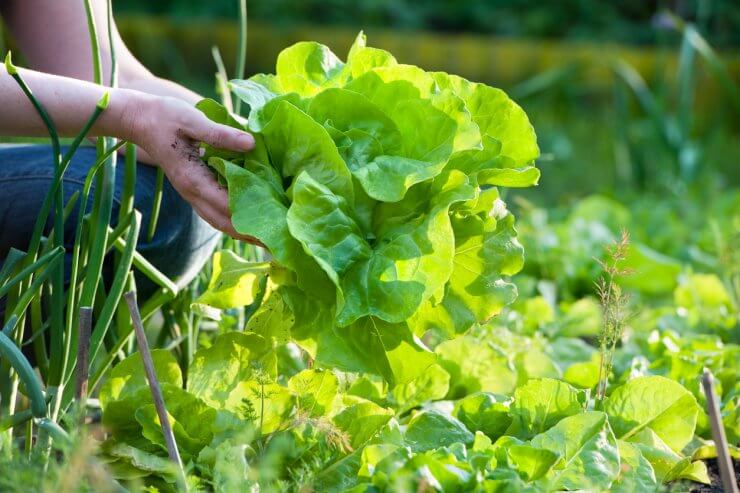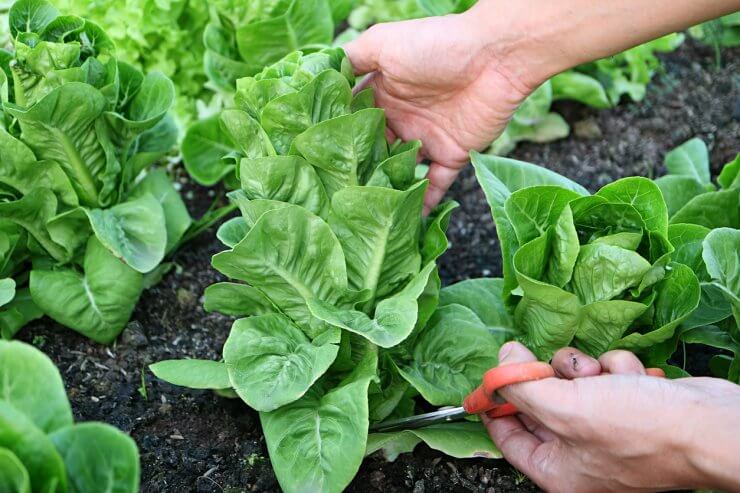
Gardener harvesting fresh lettuce
The most satisfying part of growing lettuce—aside from eating it—is harvesting it. When it comes to bringing in the lettuce harvest, it can be as quick as you like, depending on the type of lettuce you’re growing and how you like to pick your lettuce. Harvest early in the morning, when your lettuce is still cool and full of moisture.
Cut-and-come-again harvesting
One of the great things about lettuce is how it just keeps growing and growing, even when you harvest leaves as the plant is maturing. Especially with looseleaf lettuce, you can use the “cut-and-come-again” harvest method: Take your garden basket and a pair of clean, sharp garden scissors out to the garden and snip off just as much lettuce as you need for that day (and maybe the next).
You can harvest leaf lettuce and butterhead lettuce whenever the leaves are big enough to suit you. With butterhead lettuce, once the leaves start to tighten together, cut the whole head off at the soil level. To harvest Romaine, wait until the leaves have that classic white rib down the middle. A ripe head of Romaine will be standing tall with a tight cluster of leaves. Cut it off at soil level.
You can also harvest some lettuce by pulling up the whole plant. If your garden bed is getting crowded, this isn’t a bad option.
Once you’ve harvested your lettuce, wash it, dry it, and store in an airtight bag in the fridge. Keep in mind that lettuce doesn’t last that long in the fridge, so eat it as soon as possible after picking. Adding a paper towel to the bag can help your lettuce last a little longer. The exception to this is looseleaf lettuce: you should really try to eat it as soon as you can after harvest.
Lettuce has a very high water content, so it’s a terrible candidate for freezing.
Harvest before lettuce bolts
The best rule of thumb for harvesting lettuce is to harvest early and often. It’s better to harvest early than late, and the timing has less to do with days than it does to do with temperature. If you get a sudden temperature spike (remember, lettuce likes cool weather), your lettuce may bolt. When lettuce and other vegetable crops bolt, they send up a flower stalk and go to seed. In most cases, that’s a good thing—unless it’s your lettuce or a few other crops grown for their leaves (spinach, cabbage, arugula).
One of the side effects of bolting is that the plant directs all its energy to flowering and going to seed, which turns the leaves smaller, tougher, and bitter. So keep an eye on the weather. If you have a hot spell coming, get out to the garden and pick your lettuce while there’s still time.
Beating bolting

Gardener harvesting lettuce with garden scissors
You can avoid the disappointment of lettuce bolting by getting cultivars that are specifically labeled “slow to bolt.” One of our featured varieties in this collection is a lettuce called Slobolt; you could try that one. You can also focus your lettuce growing in spring and fall and avoid the heat of summer.
Some gardeners manage to grow lettuce through the summer by cultivating it in a shady spot. That strategy, combined with regular watering, can help keep the lettuce leaves cool and full of moisture.
If you have nothing but sunny spots in your garden (usually a good thing), you can set up a shade cloth to protect your tender greens. Garden centers will have the supplies you need to set up a row cover that will let the rain and sun in, but minimize the stronger summer sun that can cause bolting.
If you do see flower buds on your lettuce plants, pinch them off right away. That’s no guarantee that you’ll keep the plant from bolting, but you might buy yourself enough time to harvest the lettuce before the plant resumes its attempt to flower.
How do you harvest your lettuce? Have you had experience with your lettuce bolting? Please tell us what you look for when getting ready to harvest.


 Previous
Previous


I harvest my Romaine lettuce when it gets nice, thick leaves onboard. I don’t wait for the head to mature. We get too many heatwaves and hailstorms here in KC, KS to risk it. Besides, I can get more lettuce from the plants before they bolt! Tm.